15. “The Expulsion of Adam and Eva from Eden” by Masaccio
this painting reveals a distressed Adam and Eva, chased from the garden by a threatening angel. Adam covers his entire face to express his shame, while Eve’s shame requires her to cover certain areas of her body. I like this myth about Adam and Eva a lot and that’s why i decided to place this painting into my top  Pictura “Expulzarea lui Adam şi Eva din Paradis “elucidează starea stresantă a lui Adam şi Eva, alungaţi din grădina Paradisiacă de un înger guardian. Adam îşi acoperă faţa cu mîinele pentru a ascunde ruşinea, în timp ce ruşinea Evei o impune să ascundă şi nişte părţi ale corpului. Îmi place mitul despre Adam şi Eva foarte mult, din această cauză am şi hotărît să plasez pictura în top.
Pictura “Expulzarea lui Adam şi Eva din Paradis “elucidează starea stresantă a lui Adam şi Eva, alungaţi din grădina Paradisiacă de un înger guardian. Adam îşi acoperă faţa cu mîinele pentru a ascunde ruşinea, în timp ce ruşinea Evei o impune să ascundă şi nişte părţi ale corpului. Îmi place mitul despre Adam şi Eva foarte mult, din această cauză am şi hotărît să plasez pictura în top.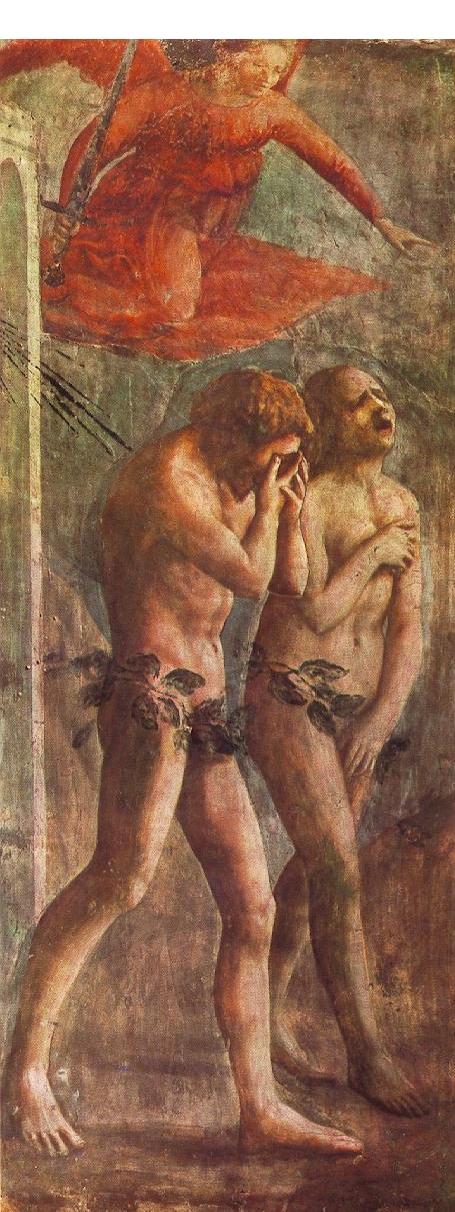
14.”The Persistence of Memory” by Salvador Dali
this painting was painted in 1931 and it’s one of Dali’s famous creations. It introduces a image of soft melting pocket watches. The general interpretation of the work is that the soft watches are a rejection of the assumption that time is rigid or deterministic. This idea is supported by other images in the work, such as the wide expanding landscape, and the other limp watches, shown being devoured by ants. I decided to post this painting, cause i think it can make everyone stronger because of the idea that not even the time can change us and the title insists that memory has more power than everything in this life. Nice idea i think!pictura “Persistenţa Memoriei” a fost creată în 1923 şi e una din cele mai faimoase picturi a lui Dali. Ea introduce o imagine a unor ceasuri de buzunar ce se topesc. Interpretarea generală a lucarării e că ceasurile moi sunt o respingere a ideii că timpul e rigid sau deterministic. Ideea e conturată şi de peisajele din urma ceasurilor şi de ceasurile devorate de furnici. Am decis să postez imaginea, deoarece consider că ea ne poate face mai puternici din cauza ideii ce o promovează, că nici timpul nu e atît de puternic, nu ne poate schimba, iar titlul lucrării insistă că memoria are o putere mai mare în viaţă. Bună idee, consider!

13.”Scream” by Edvard Munch
it shows us a little agonized figure against a blood sky. The landscape in the background is the Oslofjord, viewed from the hill of Ekerberg, in Oslo (then Kristiania), Norway. The environment of The Scream is often compared to that of which an individual suffering from depersonalization disorder experiences, such a feeling of distortion of the environment and one’s self. At the time of painting the work, Munch’s manic dipressive sister Laura Catherine was interned in the mental hospital at the foot of Ekeberg. I like this picture, cause it’s very misterious and it reveals a problem, a very big one which was the main source of inspiration i think. It’s very expressive..hmm nothing special cause Edvard Munich was an expressionist  Pictura “Strigăt” ne reflectă o figură în agonie în faţa unui cer roşu. Peisajul din urmă e regiunea Oslofjord, privită de pe dealul Ekerberg-ului, în Oslo, Norvegia. Ambianţa lucrării este deseori comparată cu starea ce simte un individ cînd simte o depersonalizare. La momentul creării, sora pictorului Laura Catherine a fost internată în spitalul de psihiatrie din cauza depresiei profunde la marginea Ekerbergului. Îmi place pictura deoarece este foarte misterioasă şi a fost inspirată dintr-o problemă importantă. Este foarte expresivă…nu e straniu căci Edvard Munch era expresionist
Pictura “Strigăt” ne reflectă o figură în agonie în faţa unui cer roşu. Peisajul din urmă e regiunea Oslofjord, privită de pe dealul Ekerberg-ului, în Oslo, Norvegia. Ambianţa lucrării este deseori comparată cu starea ce simte un individ cînd simte o depersonalizare. La momentul creării, sora pictorului Laura Catherine a fost internată în spitalul de psihiatrie din cauza depresiei profunde la marginea Ekerbergului. Îmi place pictura deoarece este foarte misterioasă şi a fost inspirată dintr-o problemă importantă. Este foarte expresivă…nu e straniu căci Edvard Munch era expresionist 
 12. “The Abduction of Deianira” by Guido Reni
12. “The Abduction of Deianira” by Guido Reniin Greek Mythology, Nessus was a famous centaur who was killed by Heracles, and whose tainted blood in turn killed Heracles. He was the son of Ixion and Nephele. He fought in the battle with the Lapiths. After carrying Deianeira, the wife of Heracles, across the river, he attempted to rape her. Heracles saw this from across a river and shot a Hydra-poisoned arrow into Nessus’s breast. As a final act of malice, Nessus told Deianira, as he lay dying, that his blood would ensure that Heracles would be true to her forever.Deianeira foolishly believed him. Later, when her trust began to wane because of Iole, she spread the centaur’s blood on a shirt and gave it to her husband. Heracles went to a gathering of heroes, where his passion got the better of him. Meanwhile, Deianeira accidentally spilled a portion of the centaur’s blood onto the floor. To her horror, it began to fume by the light of the rising sun. She instantly recognized it as poison and sent her messenger to warn Heracles but it was too late. Heracles lay dying slowly and painfully as the shirt burned his skin—either in actual flames or by the heat of poison. He died a noble death on a funeral pyre of oak branches, and was taken to Mount Olympus by Zeus and welcomed amongst the gods for his heroic exploits. The story behind this painting is very interesting and the picture is unforgettable, that’s why i chose it for my post.
În mitologia greacă, Nessus a fost un faimos centaur care a fost ucis de Heracles şi a cărui sînge nimerit pe corpul lui Heracles l-a ucis. A fost fiul lui Ixion şi Nephele. A luptat cu Lapiths, oamenii legendari ai Greciei Mitologice. Cînd soţia lui Heracles, Deianeira traversa rîul unde acesta a devenit barcagiu, Nessus a încercat să o violeze. Heracles a văzut acest lucru şi a tras cu o săgeată otrăvită în pieptul lui Nessus. Atunci Nessus a spus Deianirei că e pe moarte şi că sîngele său ar asigura veşnicia lui Heracles. Deianira l-a crezut. Astfel, ea a răspîndit sîngele lui Nessus pe o cămaşa a lui Heracles. Accidental, cînd Heracles se afla la o adunare cu eroi, Deianira a vărsat pe podea puţin sînge a lui Nessus şi acesta a început să ardă la soare. Atunci Deianira a înţeles că e otravă şi a chemat un slujitor să-l anunţe pe Heracles, dar era prea tîrziu. Heracles zăcea pe podea, cînd Deianira a intrat în cameră, deoarece sîngele lui Nessus i-a ars corpul. A avut o moarte nobilă şi a fost transporat pe ruguri de stejar la Muntele Olimp de către Zeus, unde a devenit zeul pentru faptele sale eroice. Povestea ce a inspirat această imagine e foarte interesantă şi pictura este nemaipomenită, de aceea am şi hotărît să o postez în acest top.
11. “San Gerolamo” by Caravaggio
San Gerolamo was a Catholic priest, he is best known for his for his translation of the Bible into Latin, and his list of writings is extensive. The painting depicts Saint Jerome, a Doctor of the Church in Roman Catholicism and a popular subject for painting, even for Caravaggio, who produced other paintings of Jerome in Meditation and engaged in Writing. In this image, Jerome is reading intently, an outstretched arm resting with quill. Skull on his desk reveals all the hard moments from Gerolamo’s life. It has been suggested that Jerome is depicted in the act of translating the Vulgate. I like this picture because it’s very unusual, unforgettable and reveals whole life of St.Jerome.San Gerolamo a fost un preot catolic, bine cunoscut pentru traducerile sale a Bibliei ]n latină, lista de lucrări e imensă. Pictura dată înfăţişează pe Saint Jerome, Doctor în Credinţa Catolică şi a fost un subiect foarte popular, chiar şi pentru Caravaggio care l-a desenat în mai multe picturi, unde el scria sau medita. În această pictură Jerome scrie şi în acelaşi timp se şi odihneşte. Craniul de pe masă arată toate greutăţile prin care Jerome a trecut în viaţă pentru a fi recunoscut. Îmi place pictura dată deoarece este neobişnuită, nemaipomenită şi elucidează o întreagă viaţă a lui St. Jerome.

10. “A Soul Brought to Heaven” by Adolphe William Bouguereau
this picture is just unforgettable. The idea behind this creation is that this soul represented in the picture was a good, lovely, peaceful one, that’s why it’s brought to heaven, on the other side we see these 2 angels, one dressed in red which may represent love and the other angel may be an angel of death. This is how i think, on the other sites i read that these 2 angels are it’s soul brothers, but i have some doubts. But i like this painting so much!Această pictură e nemaipomenită. Ideea ce stă la baza picturii, în primul rînd că acest suflet a fost unul curat, bun, drăguţ, pacifist, căci a fost adus în Paradis, pe de altă parte e adus de 2 îngeri, unul îmbrăcat în roşu, ceea ce ar putea să reprezinte dragostea, iubirea şi altul îmbrăcat în negru, ceea ce ar putea reprezenta îngerul morţii. Este ceea ce cred, însă am citit pe alte site-uri că aceşti îngeraşi ar putea fi fraţii sufletului, însă am dubii. Îmi place foarte mult pictura!

9.”Cupid and Psyche as Children” by Adolphe Bougereau
the story of this famous couple i exposed in my last post . I like this picture because it’s so innocent, beautiful and it kinda inspires me…and gives me a feeling that somebody somewhere is waiting for me and was made for me. oops, i’m becoming too emotional, but it’s spring guys  Istoria acestui cuplu faimos am expus-o în articolul trecut. Îmi place aceasta pictură deoarece este foarte inocentă, frumoasă şi mă inspiră într-o oarecare măsură. Îmi oferă un sentiment că cineva, undeva ma aşteaptă şi a fost sortit mie…oops, devin prea emoţională, dar e primăvara amici.
Istoria acestui cuplu faimos am expus-o în articolul trecut. Îmi place aceasta pictură deoarece este foarte inocentă, frumoasă şi mă inspiră într-o oarecare măsură. Îmi oferă un sentiment că cineva, undeva ma aşteaptă şi a fost sortit mie…oops, devin prea emoţională, dar e primăvara amici. 
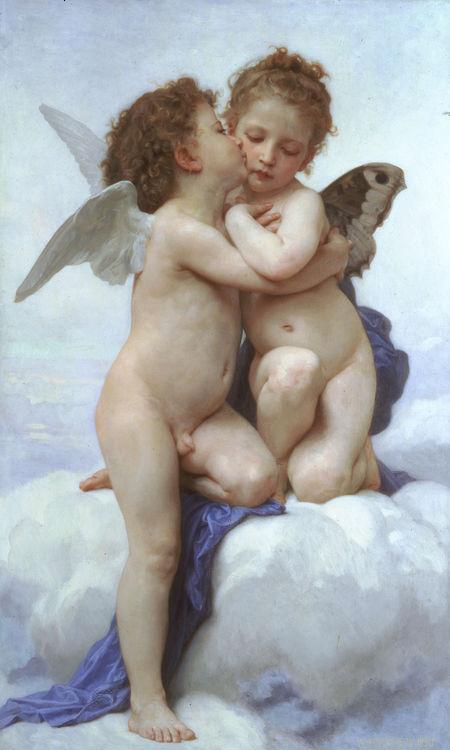
8. “The Wave” by William Adolphe Bouguereau
i like this picture because it confirms the idea that woman is against all. against water, fire, man. Woman is the most powerful creature in this world and i’m happy that i’m a future woman!Îmi place această pictură deoarece ea confirmă ideea că femeia e înaintea tuturor. Înaintea apei, focului, bărbatului. Femeia e cea mai puternică creaţie în această lume şi sunt bucuroasă că sunt viitoarea femeie!

7. “Finishing Touches” by Rob Hefferan
i’m in love with this painting cause it’s so romantic,powerful, sweet, amazing ,i think. It touched my heart. I like a lot ballerinas, maybe this is a cause why i placed this picture in my post.. but also i think it perfectly amazing picture by a very talented painter!
Sunt îndrăgostită de această pictură deoarece este foarte romantică, puternică, drăguţă, nemaipomenită, consider. M-a atins pînă-n adîncul inimii. Îmi plac foarte mult balerinele, poate aceasta e cauza de ce îmi place pictura, însă cred că e o pictură ideală realizată de un pictor talentat!
6.”Pieta” by Jacques Louis David
on 13 July 1793, David’s friend Marat was assassinated by Charlotte Corday with a knife she had hidden in her clothing. She gained entrance to Marat’s house on the pretense of presenting him a list of people who should be executed as enemies of France. Marat thanked her and said that they would be guillotined next week upon which Corday immediately fatally stabbed him. She was guillotined shortly thereafter. Corday was of an opposing political party, whose name can be seen in the note Marat holds in David’s subsequent painting, The Death of Marat. Marat had a skin disease, dermatitis herpetiformis, that caused him to itch horribly. The only relief he could get was in his bath over which he improvised a desk to write his list of suspect counter-revolutionaries who were to be quickly tried and, if convicted, guillotined. David once again organized a spectacular funeral, and Marat was buried in the Panthéon. Because Marat died in the bathtub, writing, David wanted to have his body submerged in the bathtub during the funeral procession. This did not play out because the body had begun to putrefy. Instead, Marat’s body was periodically sprinkled with water as the people came to see his corpse, complete with gaping wound. The Death of Marat, perhaps David’s most famous painting, has been called the Pieta of the revolution. I like this picture cause..i don’t know. it’s unique, i like the colors and it reveals Marat’s life, who was a very strong, self confident, ambitious man.Pe data de 13 iulie 1793, prietenul lui David, Marat a fost asasinat de Charlotte Corday cu un cuţit pe care l-a ascund în haină. Ea a intrat cu pretextul ca are lista celor care au trădat Franţa. Marat a mulţumit-o pentru listă şi a spus că ei vor fi ghilotinaţi săptămîna viitoare, iar în acest timp Charlotte a scos cuţitul şi l-a străpuns. În scurt timp, ea a fost ghilotinată. Corday facea parte din opoziţia politică, numele partidului poate fi observat în foaia pe care o ţine Marat în pictura lui David. Marat avea o boală a pielii, dermatita herpetiformă care îi căuza mîncărimi oribile. Unicul leac erau băile cu minerale pe care le practica deseori, unde a şi improvizat un mic birou în care a şi scris lista persoanelor care trebuie ghilotinate. David s-a ocupat cu înmormîntarea lui Marat şi astăzi sufletul său se odihneşte la Pantheon. Deoarece Marat a murit în cada de baie, David a vrut ca în procesul funerar Marat să fie transporat în baie, însă nu era posibil deoarece trupul a început să se descompună. Corpul lui Marat în timpul funeraliilor fu stropit cu apa astfel ca oamenii să aibă posibilitatea sa-l vadă întocmai cum a decedat, să-i vadă rana adîncă. Pictura “Moartea lui Marat” a primit denumirea de Pieta a Revoluţiei. Îmi place această pictură..deoarece..nu ştiu, este unică, îmi plac culorile şi ea elucidează viaţa lui Marat, care a fost o personalitate deşteaptă, fermă şi ambiţioasă.
5. “Pierrots Embrace” by Seignac Guillaume
this painting fascinates me by it’s colors and black – yellow contrasts, magic and emotions incorporated in that sweet and delicate kiss. The Pierrot kiss her in a very delicious place which amplifies the feelings of this woman. Seems like they are playing a game, a game inspired by love and human instincts.. absolutely beautiful painting!Această pictură mă fascinează prin culorile şi contrasturile negru-galben, magia şi emoţiile încorporate în acel sărut dulce şi delicat. Pierotul o sărută într-o zonă delicioasă care amplifică tensiunea sentimentelor acestei femei. Pare că există un joc între ei, un joc inspirat de dragoste şi instincte omeneşti…o pictură foarte frumoasă!
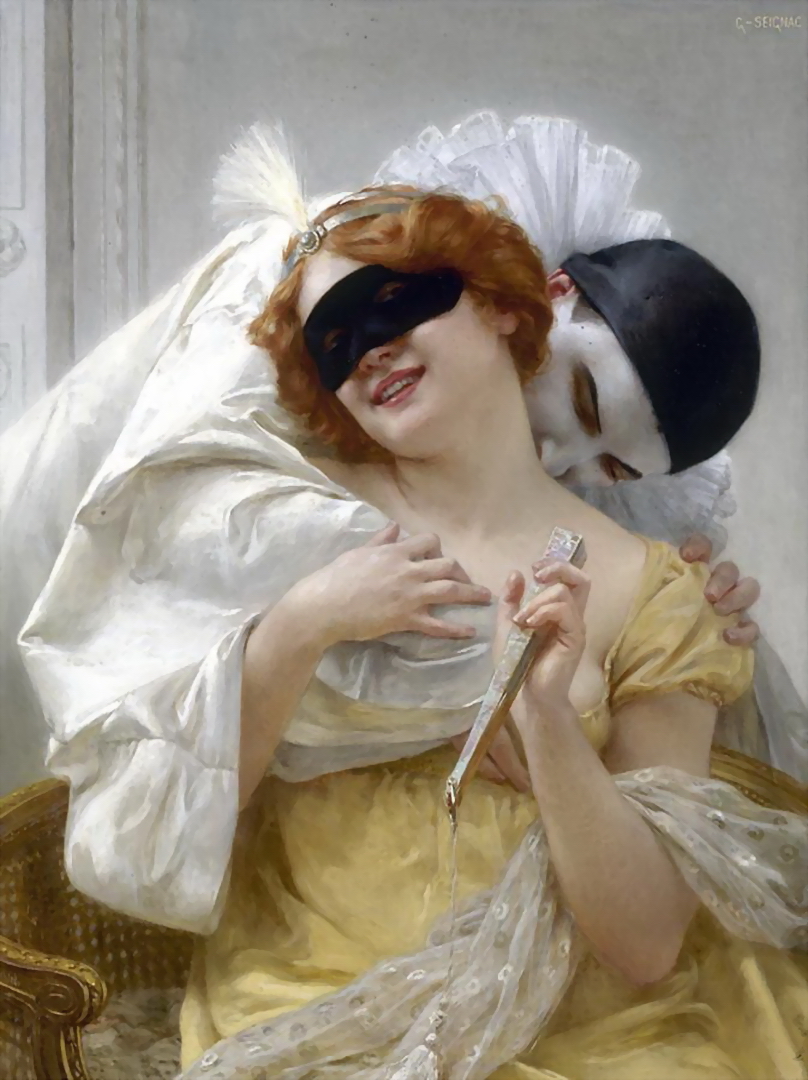
4. “Adam and God” by Michelangelo Buonarotti
The Creation of Adam is a section of Michelangelo’s fresco Sistine Chapel ceiling painted circa 1511. It illustrates the Biblical story from the Book of Genesis in which God the Father breathes life into Adam, the first man. Another point is that Adam’s finger and God’s finger are not touching. It gives the appearance that God, the giver of life, is reaching out to Adam and Adam is receiving. I like this painting cause it is very mysterious and it’s like a mirror, in the left side we see a human being who didn’t listen not to eat the apple and in the right side we see the GOD, who has a supreme power to change everything, who is a start of everything in this world, who created us [according to Bible].Creaţia lui Adam e o secţie din Fresca lui Michelangelo din Capela Sixtină pictată în 1511. Ea ilustrează o istorie din Biblie din Cartea Genezei în care Dumnezeu inspiră viaţă în Adam, primul bărbat. Un alt element e că degetul lui Adam şi al lui Dumnezeu nu se ating. Acest element ilustrează că Dumnezeu,creatorul vieţii pe pămînt, fără ca să se atingă transmite darul vieţii lui Adam. Îmi place pictura deoarece e misterioasă şi e ca o oglindă, în partea stîngă observăm o creatură omenească care a fost tentat mărului, iar în stînga îl vedem pe Dumnezeu care e înzestrat cu puterea supremă de a schimba totul, care a creat viaţa pe pămînt, ne-a creat pe noi potrivit Bibliei.
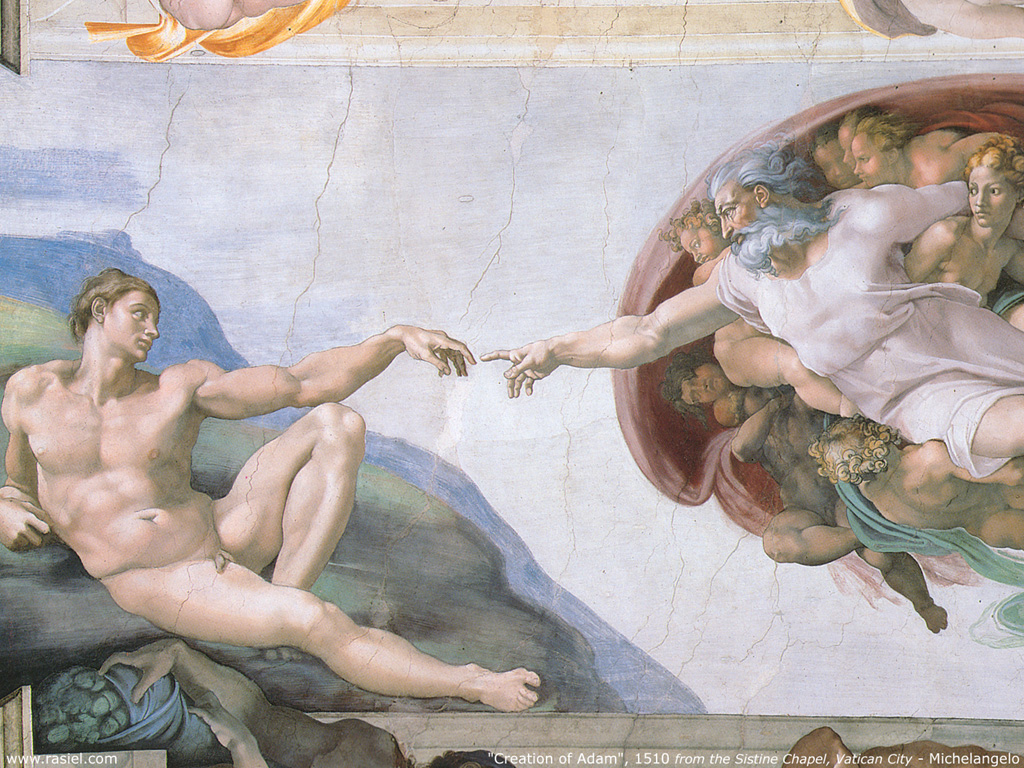 3. “Angel” by Abbott Handerson Thayer
3. “Angel” by Abbott Handerson Thayerwhen Thayer’s wife father died, Thayer’s wife lapsed into an irreversible melancholia, which caused her confinement in an asylum, the decline of her health, and eventual death, on May 3, 1891.I think this is she painted on this creation. She was like an angel for Abbott, he loved her a lot and there are a lot of paintings where his wife is painted with wings. Seems like she was a very good woman and a very devoted wife. I like this picture because it seems very special, innocent and in the same time very deep and soulful.
Cînd tatăl soţiei lui Thaye a decedat, soţia a fost pătrunsă de o melancolie depresivă ireversibilă, după care a fost izolată într-un azil şi starea sănătăţii ei s-a înrăutăţit, iar apoi a şi decedat pe 3 mai 1891. Cred că soţia este pictată pe această creaţie. Ea era ca un înger pentru Abbott, el o iubrea foarte mult căci sunt multe picturi unde este prezentată ea şi în special cu aripi de înger. Pare că era o femeie bună şi o soţie devotată. Îmi place pictura deoarece este foarte specială, inocentă şi în acelaşi timp foarte profundă şi sufletistă.2. “The Birth of Venus” by Sandro Boticelli
The Birth of Venus depicts the goddess Venus, having emerged from the sea as a full grown woman, arriving at the sea-shore (which is related to the Venus Anadyomene motif). As we can see 2 goddess are trying to blow her and the godess embodied in a simple human being is trying to cover her with a cloak. It’s a fascinating painting and it reflects all the beauty of female’s body and the relationship between the female soul and the sea.  Naşterea lui Venus o descrie pe zeiţa Venus, care evadează din mare spre ţărmul ei ca o femeie adevărată (motivul Venus Anadyomene). După cum observăm 2 zeiţe încerc să sufle spre ea, iar o zeiţă din dreapta picturii întruchipată într-o simplă creatură umană încearcă să o acopere cuo mantie. Este o pictură fascinantă şi reflectă toată frumuseţea trupului femenin şi relaţia dintre mare şi sufletul femeii.
Naşterea lui Venus o descrie pe zeiţa Venus, care evadează din mare spre ţărmul ei ca o femeie adevărată (motivul Venus Anadyomene). După cum observăm 2 zeiţe încerc să sufle spre ea, iar o zeiţă din dreapta picturii întruchipată într-o simplă creatură umană încearcă să o acopere cuo mantie. Este o pictură fascinantă şi reflectă toată frumuseţea trupului femenin şi relaţia dintre mare şi sufletul femeii.

aaaand the Winner is again “MONA LISA” by Leonardo da Vinci
the painting is a portrait and depicts a seated woman (it is almost unanimous that she is Lisa del Giocondo) whose facial expression is frequently described as enigmatic. The ambiguity of the subject’s expression, the monumentality of the composition, and the subtle modeling of forms and atmospheric illusionism were novel qualities that have contributed to the continuing fascination and study of the work. I like this painting because a lot of myths are inspired by the painting. Myths like this painting is da Vinci’s autorportret or that this is his mother or girlfriend. And i really like her smile and her lightly and warm look. I think this is a masterpiece of all times  Această pictură e un portret care descrie o femeia Lisa del Giocondo care stă aşezată. Expresia feţei deseori e descrisă ca fiind enigmatică cu un surîs abia schiţat. Ambiguitatea expresiei faciale, formele modelului şi atmosfera iluzionistă sunt calităţile care determină fascinarea tuturor. Îmi place această pictură deoarece multe mituri sunt inspirate de ea. Mituri precum este un autoportret al lui da Vinci, sau că e mamica lui, sau prietena. Îmi place foarte mult zîmbetul ei şi privirea luminoasă şi caldă. Cred că e o capodoperă a tuturor timpurilor.
Această pictură e un portret care descrie o femeia Lisa del Giocondo care stă aşezată. Expresia feţei deseori e descrisă ca fiind enigmatică cu un surîs abia schiţat. Ambiguitatea expresiei faciale, formele modelului şi atmosfera iluzionistă sunt calităţile care determină fascinarea tuturor. Îmi place această pictură deoarece multe mituri sunt inspirate de ea. Mituri precum este un autoportret al lui da Vinci, sau că e mamica lui, sau prietena. Îmi place foarte mult zîmbetul ei şi privirea luminoasă şi caldă. Cred că e o capodoperă a tuturor timpurilor.



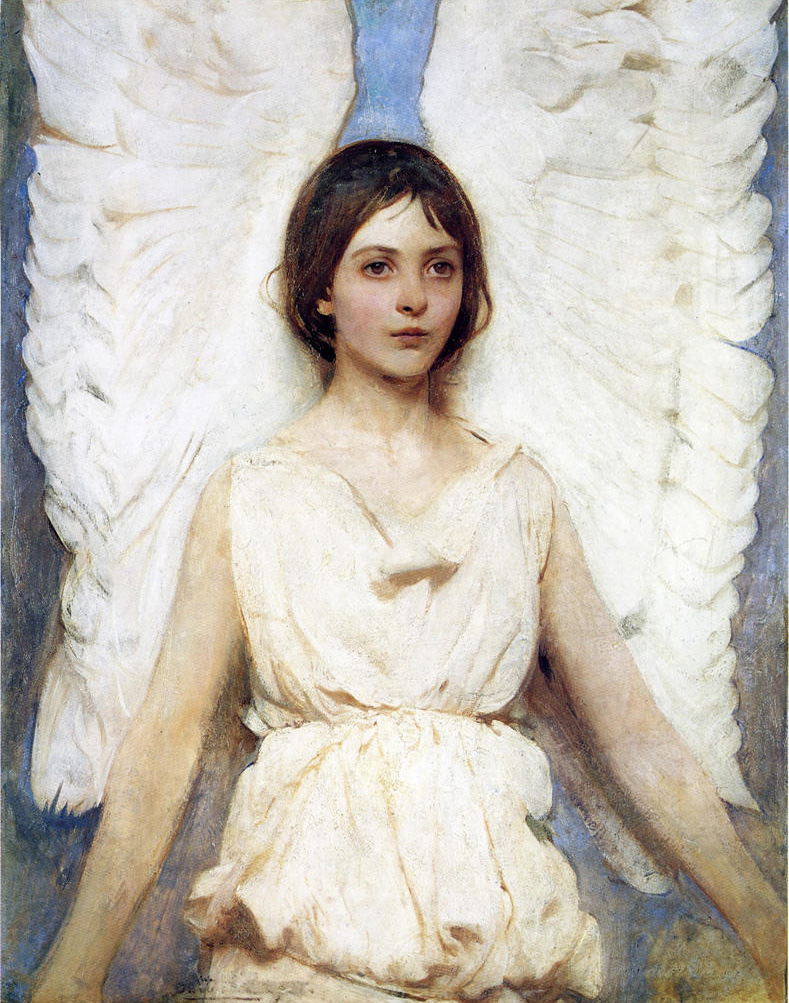
No comments:
Post a Comment